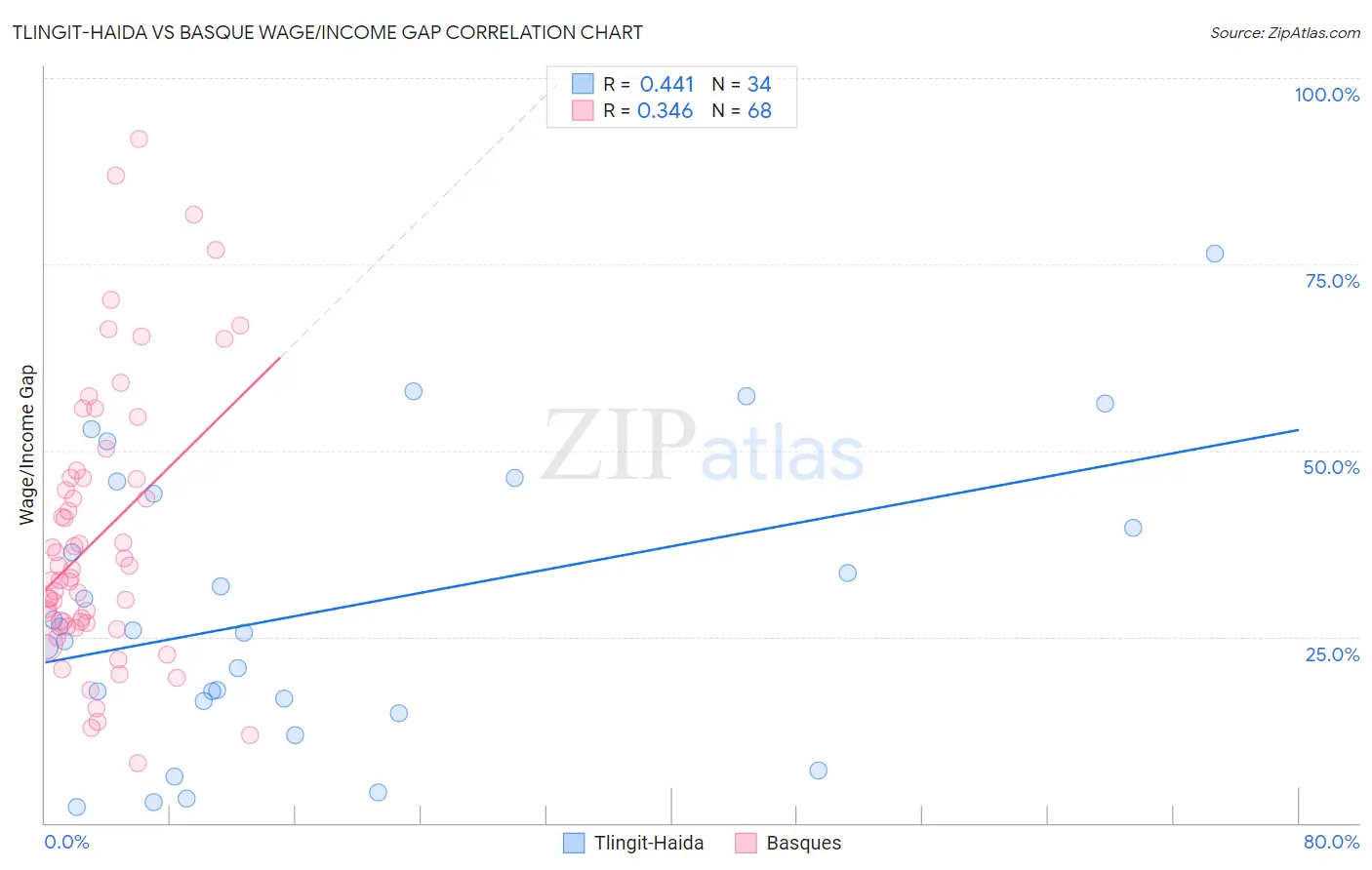Tlingit-Haida vs Basque Wage/Income Gap
COMPARE
Tlingit-Haida
Basque
Wage/Income Gap
Wage/Income Gap Comparison
Tlingit-Haida
Basques
24.0%
WAGE/INCOME GAP
98.7/ 100
METRIC RATING
104th/ 347
METRIC RANK
28.8%
WAGE/INCOME GAP
0.1/ 100
METRIC RATING
318th/ 347
METRIC RANK
Tlingit-Haida vs Basque Wage/Income Gap Correlation Chart
The statistical analysis conducted on geographies consisting of 60,845,560 people shows a moderate positive correlation between the proportion of Tlingit-Haida and wage/income gap percentage in the United States with a correlation coefficient (R) of 0.441 and weighted average of 24.0%. Similarly, the statistical analysis conducted on geographies consisting of 165,712,843 people shows a mild positive correlation between the proportion of Basques and wage/income gap percentage in the United States with a correlation coefficient (R) of 0.346 and weighted average of 28.8%, a difference of 20.2%.

Wage/Income Gap Correlation Summary
| Measurement | Tlingit-Haida | Basque |
| Minimum | 2.1% | 8.0% |
| Maximum | 76.5% | 91.8% |
| Range | 74.4% | 83.8% |
| Mean | 28.6% | 38.5% |
| Median | 25.7% | 33.4% |
| Interquartile 25% (IQ1) | 16.3% | 26.9% |
| Interquartile 75% (IQ3) | 44.2% | 46.3% |
| Interquartile Range (IQR) | 27.9% | 19.3% |
| Standard Deviation (Sample) | 18.9% | 18.3% |
| Standard Deviation (Population) | 18.6% | 18.2% |
Similar Demographics by Wage/Income Gap
Demographics Similar to Tlingit-Haida by Wage/Income Gap
In terms of wage/income gap, the demographic groups most similar to Tlingit-Haida are Moroccan (24.0%, a difference of 0.060%), Sudanese (24.0%, a difference of 0.060%), Tsimshian (23.9%, a difference of 0.33%), Yaqui (24.0%, a difference of 0.36%), and Immigrants from Albania (24.0%, a difference of 0.37%).
| Demographics | Rating | Rank | Wage/Income Gap |
| Immigrants | Sudan | 99.4 /100 | #97 | Exceptional 23.6% |
| Immigrants | Latin America | 99.2 /100 | #98 | Exceptional 23.7% |
| Aleuts | 99.2 /100 | #99 | Exceptional 23.7% |
| Yakama | 99.2 /100 | #100 | Exceptional 23.7% |
| Japanese | 99.1 /100 | #101 | Exceptional 23.8% |
| Immigrants | Laos | 99.0 /100 | #102 | Exceptional 23.8% |
| Tsimshian | 98.9 /100 | #103 | Exceptional 23.9% |
| Tlingit-Haida | 98.7 /100 | #104 | Exceptional 24.0% |
| Moroccans | 98.6 /100 | #105 | Exceptional 24.0% |
| Sudanese | 98.6 /100 | #106 | Exceptional 24.0% |
| Yaqui | 98.4 /100 | #107 | Exceptional 24.0% |
| Immigrants | Albania | 98.4 /100 | #108 | Exceptional 24.0% |
| Ugandans | 98.3 /100 | #109 | Exceptional 24.1% |
| Immigrants | Morocco | 98.1 /100 | #110 | Exceptional 24.1% |
| Soviet Union | 97.6 /100 | #111 | Exceptional 24.2% |
Demographics Similar to Basques by Wage/Income Gap
In terms of wage/income gap, the demographic groups most similar to Basques are Belgian (28.8%, a difference of 0.050%), Lithuanian (28.7%, a difference of 0.16%), Maltese (28.7%, a difference of 0.17%), Immigrants from Scotland (28.7%, a difference of 0.22%), and Slovak (28.9%, a difference of 0.31%).
| Demographics | Rating | Rank | Wage/Income Gap |
| Immigrants | Lithuania | 0.1 /100 | #311 | Tragic 28.6% |
| Eastern Europeans | 0.1 /100 | #312 | Tragic 28.6% |
| French | 0.1 /100 | #313 | Tragic 28.7% |
| Immigrants | Scotland | 0.1 /100 | #314 | Tragic 28.7% |
| Maltese | 0.1 /100 | #315 | Tragic 28.7% |
| Lithuanians | 0.1 /100 | #316 | Tragic 28.7% |
| Belgians | 0.1 /100 | #317 | Tragic 28.8% |
| Basques | 0.1 /100 | #318 | Tragic 28.8% |
| Slovaks | 0.1 /100 | #319 | Tragic 28.9% |
| British | 0.1 /100 | #320 | Tragic 28.9% |
| Welsh | 0.1 /100 | #321 | Tragic 28.9% |
| Immigrants | Singapore | 0.1 /100 | #322 | Tragic 28.9% |
| Norwegians | 0.1 /100 | #323 | Tragic 29.0% |
| Croatians | 0.0 /100 | #324 | Tragic 29.0% |
| Hungarians | 0.0 /100 | #325 | Tragic 29.0% |